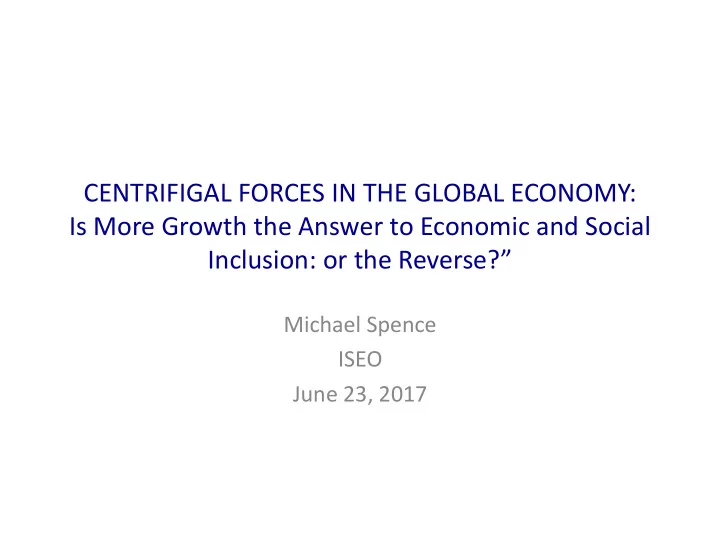

CENTRIFIGAL FORCES IN THE GLOBAL ECONOMY: Is More Growth the Answer to Economic and Social Inclusion: or the Reverse?” Michael Spence ISEO June 23, 2017
WEAK RECOVERIES IN DEVELOPED COUNTRIES
Advanced Economies Output Gap
China Grew with Little Growth in Major External Markets That is about a 63% increase
BUT • China accumulated a pile of debt • Some of that debt was used to finance assets whose value is less than the cost of creating them – hence excess capacity in heavy industries • Growth held up because – Rising incomes and middle class demand – Growth of service sector businesses – Innovation across a wide range of private sectors 5
6
USA: Investment Lagging Badly in This Cycle
Non-Routine Manual Non-Routine Cognitive Routine – Manual and Cognitive
10
11
3D Printing
17
USA Income Distribution Trends
MEAN AND MEDIAN HOUSEHOLD INCOME USA 19
USA: Employment Creation
USA: Value Added and Growth
USA Value Added per Worker
23
24
USA MEDIAN HOUSEHOLD INCOME 26
Europe
Europe: Labor Cost Divergence 29
30
31
2014 STUDY BY RODRIK et al 32
33
Productivity: Multidimensional Measurement of Economic and Social Progress • Captures the specifics of growth patterns – Income, health, security, environment, distribution/fairness, social interaction and connectivity • Social Media • Science Budgets (NIH $32 billion) ( NSF+DOE science $12 billion) • What if productivity is slowing because there are more important priorities • And society (via markets, individual choices, social choices and policies) is allocating most value resources to to other important dimensions • The China Case 34
FRED HU is Founder and Chair of Primavera Capital Group. MICHAEL SPENCE is William R. Berkley Professor in Economics and Business at New York University’s Leonard N. Stern School of Business. He received the Nobel Prize in Economics in 2001. 35
Global Growth Patterns • Occurred under the post war architesture • Produced war recovery, high growth • Distributional aspects of growth patterns were largely benign • That changed in the late 1970’s • Since then, growth held up until 2008 crisis. • But Distributional aspects of growth patterns deteriorted • That trend accelerated post 2000 36
The Year 2000 Was a Turning Point • Survived Y2K scare for computers/dates • China entered WTO • Eurozone came into existence and expanded • Digital technology impact on jobs, economic structure, the complexity of global supply chains accelerated dramatically • Multifiber agreement expired – end of 2004 • Internet Bubble • 911 – followed by war in middle east 37
Globalization and Growth Patterns Now • Global economy is characterized by flows of – Goods and services – Capital – Information/data/ knowledge and technology – People • Today virtually every aspect of this framework is under assault or in question now, creating tremendous uncertainty about what the future holds in terms of opportunities and risks. 38
Goods and Services • Trump – some form of rejection of multilateralism • Brexit • Anti-Europe and anti-Euro parties in Europe • NAFTA, TPP, TTIP, WTO, PARIS • “Renegotiate” the terms of engagement • China and Europe remain committed to some form of multilateral structure • China has become a principal sponsor • AIIB, OBOR, Development banks, swap agreements 39
Capital • It has become clear that unrestricted capital flows are at best a double-edged sword. • Especially in a world of highly unusual and potentially distortive monetary policies • Developing countries have had to try to protect themselves from volatile tourist capital flows • China has had to partially shut off outbound capital flows to maintain stability (in the short to medium term) 40
People • Immigration is a major challenge • In Europe, the absorptive capacity with respect to Africa and middle east refugees is not large enough to absorb the flow • More generally, immigration has become a symbol of lost of sovereignty and cultural identity 41
Data Information and Technology • Cyber security threats in multiple dimensions have simply blown away the earlier naïve notion that a globally open internet based system was the new normal – Privacy – Cyber warfare – Industrial espionage – Terrorism – Fake news and related manipulation 42
The Bottom Line • Powerful forces causing fragmentation and polarization within societies and across countries • This polarization is caused in part by a failure by elites and governing bodies to address the problematic aspects of growth patterns as outlined above • Yet global cooperation is crucial – For sustainability – For specifically climate change – For early stage developing countries 43
Key Elements in Sustain Global Cooperation • Restore inclusiveness to growth patterns – Investment in human capital – Enhanced social security systems – Income redistribution – Where needed, removal of obstacles to growth • Accept that international structures can get outdated and need cooperative revision to reflect an evolving reality • The major players are now a mix of countries at various stages of development. They will have to work together. 44
45
Recommend
More recommend